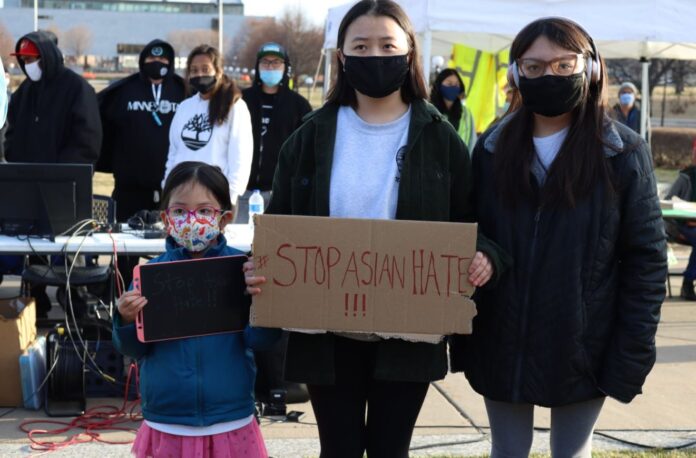What does it mean to be Asian in America? A new qualitative study from the Pew Research Center examines how Asian Americans are grappling with their Asian identity in America.
In fall 2021, the Pew Research Center conducted 66 focus groups with a total of 264 participants from 18 Asian ethnic origin groups. The participants discussed their experiences as Asian Americans.
“Asian American” as a pan-ethnic label
Several participants said that using the term Asian was “less of an active choice and more of an imposed one.” Many identified more with their specific groups than the larger “Asian American” label.
“I guess … I feel like I just kind of check off ‘Asian’ [for] an application or the test forms. That’s the only time I would identify as Asian. But Asian is too broad. Asia is a big continent. Yeah, I feel like it’s just too broad. To specify things, you’re Taiwanese American, that’s exactly where you came from,” said a Taiwanese American woman in her early 20s.
A Nepalese woman participating in the study also noted she has to check the “Asian American” box because there often is no option for Nepalese Americans on forms. Other participants implied that the “Asian American” label is easier to use because many Americans are not familiar with smaller Asian ethnic groups.
Participants also discussed other identities beyond race and ethnicity that were important to them like gender and sexuality.
“I belong to the [LGBTQ] community … before, what we only know is gay and lesbian. We don’t know about being queer, nonbinary,” a Filipino immigrant in her early 20s said in a focus group. “[Here], my horizon of knowing what genders and gender roles is also expanded … in the Philippines, if you’ll be with same sex, you’re considered gay or lesbian. But here … what’s happening is so broad, on how you identify yourself.”
Immigration
Immigrant participants discussed how they view their “American identity.” Many said they slowly defined what it means to be “American” as they experienced their new lives in the United States. For several participants, becoming American has more to do with how you adopt the culture (learning the customs and language) than how long you have lived in a place.
“Every time I go to a party, I feel unwelcome. … In Korea, when I invite guests to my house and one person sits without talking, I come over and talk and treat them as a host. But in the United States, I have to go and mingle. I hate mingling so much. I have to talk and keep going through unimportant stories,” a Korean immigrant woman in her mid-40s.
Focus group members who were immigrants also said it was easier to socialize with people who shared their ethnic identity.
Stereotypes, Model Minority Myth, Perpetual Foreigners
The 264 participants also discussed how non-Asian Americans perceived them.
Non-Asians are often confused about specific Asian identities. Focus group participants described instances when they had to explain their identities. Participants from smaller ethnic groups said they were often misidentified as belonging to larger ethnic groups.
For some, ignorance about specific Asian identities comes at a high cost. A Pakistani American in his mid-60s said he was harassed frequently after 9/11 because people thought he was Arab.
“There [were] a lot of instances after 9/11. One day, somebody put a poster about 9/11 [in front of] my business. He was wearing a gun. … On the poster, it was written ‘you Arabs, go back to your country.’ And then someone came inside. He pointed his gun at me and said ‘Go back to your country,’” he said.
Participants also discussed the harm the model minority myth has caused. The model minority myth paints Asian Americans as a successful minority group that works hard, often without complaint. For several participants, the expectations outlined by the myth don’t match the impoverished experiences of their ethnic groups.
It is hard for many non-Asian Americans to recognize that Asian Americans are also Americans. They view Asian Americans as perpetual foreigners. Several participants said that non-Asians would ask often ask them where they were really from.
“I find that there’s a, ‘So but where are you from?’ Like even in professional settings when they feel comfortable enough to ask you. ‘So – so where are you from?’ ‘Oh, I was born in [names city], Colorado. Like at [the hospital], down the street.’ ‘No, but like where are you from?’ ‘My mother’s womb?’” U.S.-born woman of Indian origin in early 40s said.
AsAmNews is incorporated in the state of California as Asian American Media, Inc and has an application for non-profit 501c3 status with the IRS pending. Check out our Instagram account. Go to our Twitter feed and Facebook page for more content. Please consider interning, joining our staff, or submitting a story, or making a financial contribution. We are committed to the highest ethical standards in journalism. Please report any typos or errors to info at AsAmNews dot com.





I’m in my 70s and a 5th generation Chinese American and things are still the same. Same questions asked of us, same comments. Time has passed but non-Asians haven’t budged in regards to how they view Asians. White Americans still think they’re the only real Americans. The rest of us are always having to explain that we are, too. As a psychotherapist and a storyteller my job will not ever end as long as non-whites are kept outside by the majority white. And now it’s worse. We are being violated, harassed and even killed for not being white … for being who we are.
Asian Americans are diverse, and of different generations and immigration experiences. How people identify depends primarily on their relational experience, and broadly speaking, Asians share a more relational and interdependent identity experience, and overall less individualistic. So the group affiliation is and has been more important during the rise in anti-Asian hate as well – though of course there’s always tension and collaboration with being an individual as well. But those who haven’t had relational experiences with others of their own ethnicity or the broader Asian American community tend to devalue the label most – like Jay Caspian Kang, whom I wrote about here – MOSF 16.7: Jay Caspian Kang and The Loneliest Americans vs. the Psychology and Reality of Asian America https://eastwindezine.com/mosf-16-7-jay-caspian-kang-and-the-loneliest-americans-vs-the-psychology-and-reality-of-asian-america/ Asian America has been deprived of belonging – in numbers and ability to affiliate. I think our ability to deepen our commitments and our affections for one another have been severely tested because of the dominant culture’s centralization of White Male Christianity. I wrote “But how can you belong to a community that has itself been deprived of belonging, that has anesthetized itself from its possibility, yet remains in denial of the surgeon’s knife which threatens to carve us apart as if we weren’t one body at all?” in Memoirs of a Superfan Vol. 15.2: Lama Rod Owens and the Emotional Body of Asian Americans https://eastwindezine.com/memoirs-of-a-superfan-vol-15-2-lama-rod-owens-and-the-emotional-body-of-asian-americans/ We are at an inflection point between social dominance orientation and what I term relational-cultural-contextual orientation in Asian American and human affairs. Authoritarianism and autocracy are on the march, and we must deepen our relational commitments actively and consciously. I wrote about the latter issues here – MOSF 17.8: From Bad Axe to Chinatown to Hong Kong, Let Freedom Ring! https://eastwindezine.com/mosf178-let-freedom-ring/